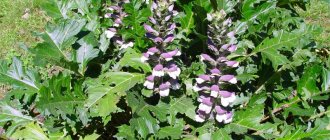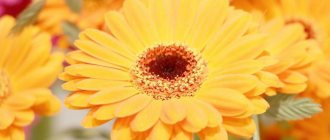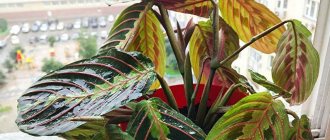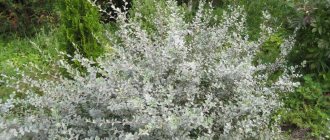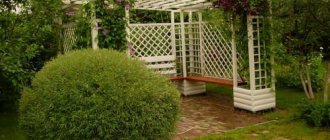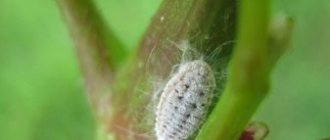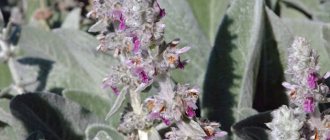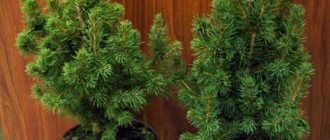This hardy and truly tenacious perennial can often be found in spacious meadows and forest clearings in central Russia. Why is it interesting to gardeners? With its unsurpassed vitality and adaptability to almost any conditions and, of course, the fact that during flowering it turns not the most cozy corners of the garden into pretty sky-blue rugs. The tenacious creeping grass also got its name for a reason - it easily spreads across the site, occupying empty spaces. Together with easy and unburdensome care, tenacious flowers can be recommended for planting in large garden plots if it is impossible or unwilling to cultivate the entire local area for gardening needs. Like any ground cover, tenacious will perfectly fill the voids between other ornamental or fruit-bearing crops.
General description with photo
The second name of the plant is ayuga. Belongs to the family Lamiaceae or Lamiaceae. The plant easily adapts to various soil and climatic conditions and does not require constant attention and care. In essence, this is the most common perennial of our fields and meadows, having a wide distribution from middle latitudes to rather harsh northern climatic zones.
The survivor rarely reaches 30 cm in height, and even then together with the peduncles raised upward. For this reason, they are clearly visible during flowering, which is usually long and abundant (depending on the species). In the basic variety, the flowers are sky blue or bluish-violet, less often yellow, but decorative varieties of tenacious can also produce inflorescences in white and pink tones.
Options for using creeping and pyramidal tenacious in garden decor
There are many options for using this plant to decorate the garden. The fact is that the tenacious plant has a variety of shapes, covers the ground well, creates a contrasting background that favorably emphasizes other flowers.
Also read: Phlox in the garden: methods of propagation, features of planting and care
Moreover, the plant can be used not only as an independent design tool, but also in combination with many other flowers and garden greens:
- Pyramid tenacious has flowers of dark purple, blackberry shades; they are located on elongated narrow ears, which creates a good effect of rising in height. They can be used to frame different sectors of the garden, planted along the perimeter (this creates a beautiful flower border that highlights the contours of the area), as well as according to a pre-made pattern - for example, waves and zigzags.
- You can create small flower beds from tenacious flowers, alternating them with taller flowers in order to favorably emphasize both. The effect of contrast will be manifested due to differences in heights, as well as due to the dark shades of the flowers of the pyramidal tenacious plant (or the green part of the Black scallop plant).
- It is very beautiful to frame flower beds made of tenacious flowers with decorative roots in white shades. This looks especially appropriate when creating a flower garden in the style of a rock garden - it creates the effect of snow-capped peaks on which flowers grow (for this you can plant plants on hills or hills).
- A very successful decoration option is to plant the survivor on the shore of a country pond under taller plants. This creates the effect of a coastal forest with beautiful flowers along the pond.
- Ayuga can be grown next to coniferous plants - together the composition will create the effect of movement and upward direction.
- Also, the tenacious plant looks harmonious with ferns, which contrast with it in the shades of the leaves and at the same time are located on approximately the same tier.
- An excellent combination is created by tenacious with iris, the bright flowers of which look good against the backdrop of solid green carpets of ayuga.
- Finally, the most universal option is to plant the plant in all unused areas that look unsightly due to the blackening soil. The tenacious will cover all open spaces well and create an original green carpet effect.
Types and varieties with photos
Among the varieties of tenacious, there are evergreen, deciduous, and representatives of the intermediate class.
Herringbone tenacious
A very low-growing species, spreading like a carpet up to 6 cm. It has gray-green leaves with jagged edges, in appearance reminiscent of the scales of a husked pine cone. The similarity is complemented by a pleasant light pine aroma. It blooms with yellow flowers for a very long time, from spring days to late autumn. Loves light and fairly dry soils, responds extremely positively to organic matter and mineral complexes. It is not very aggressive towards neighboring crops.
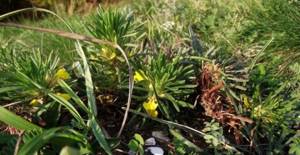
Geneva survivor
A more southern variety, found everywhere in the Crimea and the Caucasus region at altitudes up to the middle of the mountain ranges. The root system is very superficial and extensive. The height of the densely pubescent shoots can vary greatly from creeping, squat to 30-40cm. The lower short-petiolate leaves form a dense rosette; on the shoots the leaves are sessile and have a different, obovate shape with a dissected-toothed edge. It blooms from May to June, but can produce foliage twice and bloom a second time. This species is not prone to spreading throughout the area and does not require control or strict territorial restrictions.
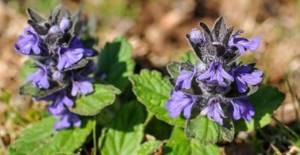
Interesting fact. Ants take part in the natural reproduction of the survivor.
Pyramidal survivor
This variety of culture comes from Europe, where it grows even in remote places and on very poor rocky soils. An extremely easy-to-care perennial. It has an external resemblance to the creeping species, but is less tall, does not exceed 25 cm. It also differs in that it does not form continuous coverings. The shoots have very dense pubescence, and the leaves also have a fleecy surface. The flowers of selected varieties can be bright blue, white or beautiful pink.
The most popular variety is “Metallica Crispa” with very decorative, highly folded leaves of a bizarre spider-like shape, shimmering with a metallic sheen.
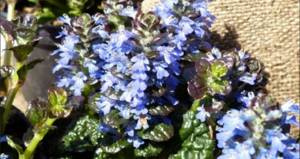
Creeping tenacious
The most famous species in Russia, it also grows in many other European and Asian countries. Loves wet meadows, mixed forests and even bushes. The root system is racemose, fibrous, creeping, shoots take root easily and produce new leaf rosettes. The stems have soft matted pubescence. The lower basal leaves are narrowed, sitting on elongated petioles, the upper stem leaves are sessile, their petioles are very short. The third type of leaves are bracts, have a solid shape and often turn blue at the base. It is a polymorphic variety and has a short flowering period of about 20 days from May to June.
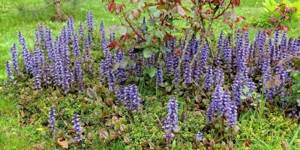
The most decorative breeding varieties with photos
- "Atropurpurea" - leaves with a bronze-brown tint, heavily wrinkled. Forms dense and dense clumps up to 8 cm high. The most sun-loving variety among others. It can grow in relative shade, but will be less beautiful.
- "Burgundy Glow" is attractive for its variegated leaves, the variegation of which depends on the characteristics of the soil and light. The color of the foliage may contain reddish and lilac notes. Prefers semi-shaded places.
- “Black Scallop” - has glossy, very decorative leaves.
- "Multicolor" is another variety with variegated foliage.
The tenacious plant can grow in one area for a very long time, since it is practically not subject to degeneration and growth like many other ground covers.
Varieties of survivors
Scientists-breeders have bred 45 varieties of tenacious, differing in the color of foliage, flowers, and stems.

In Russian forests, the hairy tenacious tree is most often found, thanks to which other varieties were bred, which turned out to be much better than their predecessor.
Tenacious Chios
The variety grows 10–25 cm in height, is a shrub that is formed by three shoots extending from the base. The flowers of the plant are small, yellow with purple speckles.

The leaf blades of the variety are small and thin, dark green in color, slightly pubescent. The tenacious Chios plant has become popular due to its decorative qualities. Its flowering period runs from late spring to early autumn. Another positive quality is the ability to grow on terrible soils.
Geneva's tenacious
This variety is also often called the tenacious hairy one. The shoot of the variety is similar to the shoots of Chios tenacious. The only difference is the absence of creeping stems in the Geneva tenacious. The bush grows 30–50 cm in height, the shoots are pubescent.
The leaf blades are long and narrow. Geneva's tenacious plant is covered with lilac flowers. It is worth noting that the variety is most often used for medicinal purposes.
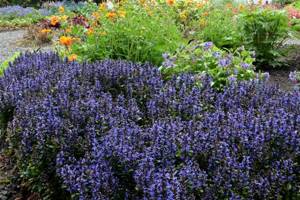
The variety has a variety called Blue Sea. It is a ground cover grass that grows up to 25 cm in height. It blooms with small pale blue flowers. The leaf blades are dark green, elliptical in shape. The plant is unpretentious to growing conditions.
Pyramidal survivor
The pyramidal tenacious does not grow as quickly and does not grow as much as other varieties. But it is drought resistant. The shoots are pubescent, the leaf blades resemble an oval in shape, the edge is jagged. The variety got its name due to the fact that the upper part of the shoot resembles a pyramid.
The tenacious Metallica Crispa is the most beautiful representative of the variety. The leaves are shiny, black-green. The species is listed in the Red Book. The stems are fragile, so you should be careful when transplanting or planting. It is better to choose a landing place away from where people walk.
Creeping tenacious
A variety of creeping tenacious is a light-loving bush. The leaves are dark red or brownish. The species of creeping tenacious, Atropurpurea, is a creeping crop that grows up to 20 cm in height. Blooms with dark blue flowers.
Another variety of creeping tenacious is Burgundy Glow. This species is the most changeable, because the color of the leaves depends on the substrate and components, as well as on the illumination of the crop by sunlight. The veins on the foliage are creamy, and the leaves themselves are green, pink with a blue tint, and the like. By the way, when you plant a pink rosette and then divide it for propagation, you will get plants of all kinds of colors.
Reproduction of ayuga
Since the plant is characterized by high vegetative activity and territorial mobility (creeping tenacious), there are no problems with reproduction, and gardeners very rarely resort to seed propagation. The flower produces numerous above-ground stolons; its shoots initially have a horizontal direction of growth, but at the point of contact with moist soil they easily take root and form a new terminal point of growth. After this they begin to grow vertically. In the second half of summer, a green leaf rosette forms on a vertical stem, in the center of which a future inflorescence is formed, which can be seen next year. However, in some cases, flowering may begin already in the current year for the second round. The horizontal shoot itself completely dies off by the beginning of cold weather; only new leaf rosettes remain green, which remain so until spring, if we are talking about an evergreen variety.
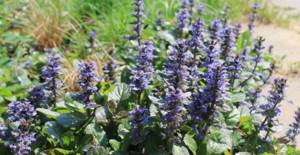
By dividing the rhizome
If you need to move the plant to another area, it is convenient to use the method of dividing the rhizome. To do this, the dug rhizome is divided into stolons so that each has 2-3 internodes. After this, they can simply be laid out on moist soil, without being buried in such a way that the apical bud is located at least 0.5 cm above the soil.
The method of dividing the rhizome is available only for creeping tenacious and its variegated form “Rubra”.
Bush sockets
You can propagate ayuga by dividing the bush into rosettes. This can be done at any time, starting in early spring, the deadline is the second ten days of September. The optimal planting material is “islands” of about 5 cm2, formed from 3-5 rosettes, but this is not always possible. If the material is limited (rare variety), single rosettes can be used for planting. Moreover, even a damaged equine system, if there is at least a small intact part (thread), is viable to produce full-fledged offspring. As the rosettes grow, they can be planted continuously within the allotted time frame. They should be planted according to a 10-15 cm pattern.
The method is available for almost all varieties of tenacious and its varietal lines.
Growing conditions and care for survivors
Growing
Despite the fact that the plant is very unpretentious, the ideal soil for planting is well-moistened, humus-rich loam. In summer, it can go up to 4 weeks without watering. During this period, the plant will lose its decorative appearance, but will quickly recover if watering is increased.
Seeds of creeping tenacious have a high germination rate: they can be sown in open ground in spring or autumn, before winter. Vegetative propagation is possible by dividing the rhizome or bush into rosettes.
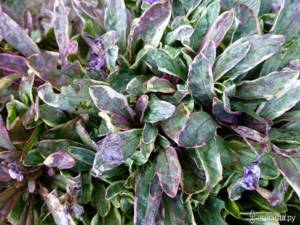
Creeping tenacious Dixie Chip
Landing
In early spring, after the snow has melted, you can plant young plants. The distance between each outlet should be about 20-30 cm, depending on the type chosen. The plant can survive short-term frosts down to -8...-10 degrees. The growing point is left above the soil surface, watered abundantly during planting and during the first two weeks after it.
Watering
Most varieties prefer abundant watering. It is enough to water an adult plant once a week during the hot season.
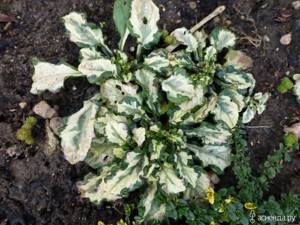
Creeping tenacious Arctic Snow
Diseases and pests
Ayuga almost never gets sick, with the exception of fungal diseases. The plant is exposed to this disease extremely rarely, only in very neglected gardens. The only pests of the plant are garden snails and slugs. You can get rid of them by watering the soil with lime mortar or by placing toads in the garden.
Transplantation and propagation
Growing ayuga is easy even for a less experienced gardener. Young plants are planted in well-moistened soil. If the plant grows in one place for more than five years, then it is necessary to apply nitrogen fertilizers and fresh soil.
In March, after the snow has melted, you can reproduce by dividing the rosette. A heavily overgrown plant can be planted from May to September; to do this, it is enough to separate part of the creeping stem with rhizome. The superficial rhizome does not require deep loosening, so caring for the creeping tenacious plant in open ground comes down to periodic watering.

To grow tenacious plants from seeds, it is better to use planting material from the store, since most varieties are hybrids, the daughter plants will not bear all the maternal characteristics.
Choosing a place to plant survivors
Actually, this question in relation to this completely unpretentious plant is completely unimportant. It can grow in an area completely exposed to the midday heat and can even tolerate dense shade. The situation is the same with the soil issue. Ayuga tolerates heavy, loose, and waterlogged soils. But, if you have the opportunity to choose, then she will prefer nutritious, humus-rich areas, moist loam and shimmering, sliding shadow.

Wintering
As is already clear from the habitat of the tenacious species in the wild, it tolerates cold winters easily, as well as spring-autumn frosts in the absence of snow cover. However, it often happens that plantings that are too thick and not young emerge from under the snow in the spring slightly frozen, which does not happen with young plants. After the snow melts, they appear in all their glory with their bright and shiny, bronze foliage. But the situation is not critical in any case, since even a frozen plant recovers very quickly with the onset of the first warm days.
Diseases and pests
Fortunately, the plant easily tolerates many negative environmental factors and care errors. Even excessively waterlogged soil and other stagnant phenomena do not cause putrefactive processes. But, if this happens against the backdrop of low temperatures, the survivor may be attacked by slugs and snails. At the same time, they will eat, first of all, the most delicate and beautiful leaves, and they do this mainly at night. To avoid misfortune, the area must be cleaned of organic debris and stones, under which snails like to hide, and still choose well-drained places for planting. You can also repel harmful insects with the help of superphosphate, which is scattered between the rows on plastic film in dry weather.
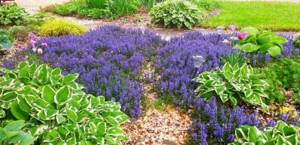
Technology for growing creeping tenacious from seeds
As already mentioned, the plant does not require special care conditions, so growing a survivor will not be difficult. It is grown directly from seeds. At the same time, seeds of almost all varieties are available for sale. In this case, planting seeds is carried out not only in spring, but also in autumn.
In addition to its unpretentiousness, the plant has a number of other advantages:
- it has flowers and foliage of various colors, which allows it to be widely used in garden decoration;
- the plant does not compete with other inhabitants of the garden, since the root system grows in breadth and does not take away water and nutrients from its neighbors;
- survivors reproduce well vegetatively (using shoots);
- they destroy many weeds due to the fact that they cover the entire adjacent territory with their thick greenery, thereby not giving them light;
- They are highly resistant to cold, hot climates and pests.
Also read: The most common types of astilbe and their growing conditions
Creeping tenacious: care in the fall (video)
Preparatory work and site selection
You can choose almost any place for survival, except for obviously shaded and overly sunlit surfaces. The plant prefers light, variable shading, which is achieved when planted next to garden trees and tall flowers.
When it comes to soil, plants most like moistened loams and cultivated garden soils. For their better and faster growth, you can use superphosphate fertilizer in an amount of approximately 90-100 g per square meter of soil surface.
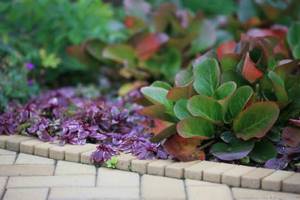
You can choose almost any place for living, except for clearly shaded and overly sunlit surfaces
Features and timing of planting creeping tenacious
Planting of the tenacious plant is carried out on dry days . At the same time, you can start planting even in early spring, since the plant is resistant to cold (withstands fluctuations up to 9-10 degrees below zero).
Seeds need to be planted along pre-designated lines (when preliminary designing the design of the future garden) at a distance of at least 30-35 cm from each other. Immediately after flowering (usually observed at the end of May), the plant will produce many shoots and spread widely over the surface.
Another important feature that must be taken into account when planting is that the tenacious plant will completely cover the ground with its leaves. Therefore, it makes no sense to plant low plants next to it - the tenacity will not allow them to develop and will completely block access to sunlight.
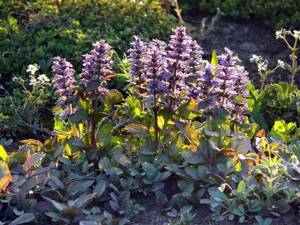
The tenacious plant will completely cover the ground with its leaves.
Application in landscape design
Tenacious is one of those few groundcovers that grow well in the most unfavorable soil conditions - areas with a lot of stones, in crevices between large cobblestones, on slopes and in the limited space of borders along garden paths. Ayuga is very good for spacious rock gardens, but it has no place on small and cramped alpine hills. If the terrain is very uneven, hilly, this ground cover will give it amazing structure. It's also a great way to cover up an unsightly corner of the garden or an empty patch of infertile land where nothing else wants to grow. You can also use this plant for container planting as a hanging crop for landscaping garden gazebos, since it is not afraid of drafts and windy places. And a novice gardener who has no experience in growing capricious ground cover crops should pay attention to tenacity to gain his first experience, which, thanks to its unpretentiousness, will certainly be successful.
